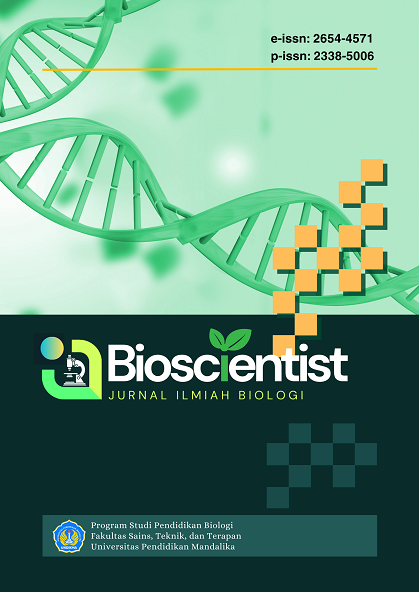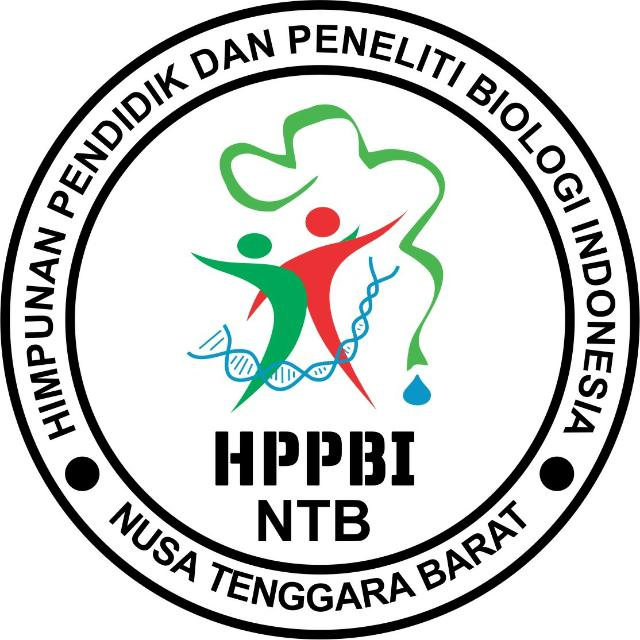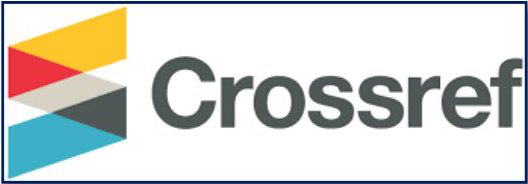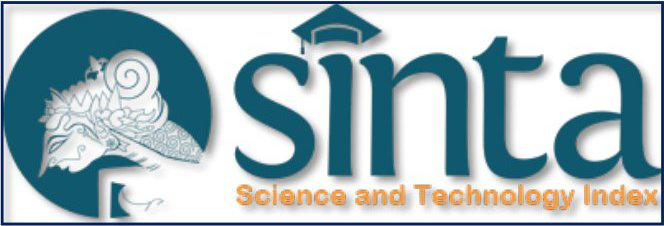Identifikasi Tahap Perkembangan Mikrospora melalui Ukuran Floret pada Jantung Pisang Tanduk
DOI:
https://doi.org/10.33394/bioscientist.v13i4.17681Keywords:
Jantung pisang, mikrosporogenesis, kultur mikrospora, floret, brakteaAbstract
This study aimed to identify the relationship between floret length and the developmental stages of microspores in banana male inflorescence (Musa spp. cv. Tanduk), and to determine the optimal floret size range as an explant source for initiating microspore culture. Ten bract layers were analyzed, with five florets randomly selected from each layer and measured for their length. Anthers were extracted from each floret, crushed in sterile water, and observed microscopically using a wet mount preparation. The results revealed a strong correlation between floret length and microspore developmental stages. Microspores at the late uninucleate (vacuolated) to early bicellular stages were consistently found in florets ranging from 4.68 to 4.34 cm in length. Based on these findings, florets within the 4.60 to 4.00 cm range are recommended as the optimal size for microspore culture initiation, as they contain a higher proportion of developmentally competent microspores for embryogenesis induction. In conclusion, this study provides essential morphological and cytological criteria to support efficient explant selection for in vitro regeneration of banana through the microspore culture approach.
References
Baillie, A. M. R., Epp, D. J., Hucheson, D., & Keller, W. A. (1992). In vitro culture of isolated microspores and regeneration of plants in Brassica campestris. Plant Cell Reports, 11(3), 234–237. https://doi.org/10.1007/BF00235072
Calabuig-Serna, A., Mir, R., Sancho-Oviedo, D., Arjona-Mudarra, P., & Seguí-Simarro, J.M. (2024). Calcium levels modulate embryo yield in Brassica napus microspore embryogenesis. Frontiers in Plant Science, 15. https://doi.org/10.3389/fpls.2024.1512500
Cristea, T. O., Iosob, G.-A., Brezeanu, C., & Brezeanu, M. (2021). Effect of Chemical Composition of Nutritive Medium and Explant Size Over Androgenetic Response in Microspore Culture of Brassica oleracea L. Rev. Chim, 71(10), 131–136. https://doi.org/10.37358/Rev.Chim.1949
Darvari, F.M., Sariah, M., Puad, M.P., & Maziah, M. (2010). Micropropagation of some Malaysian banana and plantain (Musa sp.) cultivars using male flowers. African Journal of Biotechnology, 9(16): 2360-2366. http://www.academicjournals.org/AJB
Gamborg, O.L., Murashige, T., Thorpe, T.A., & Vasil, I.K. (1976). Plant tissue culture media. In Vitro Cell.Dev.Biol.-Plant 12, 473–478. https://doi.org/10.1007/BF02796489
Hale, A. L., Farnham, M. W., Nzaramba, M.N., & Kimbeng, C. A. (2007). Heterosis for horticultural traits in broccoli. Theoretical and Applied Genetics, 115(3), 351–360. https://doi.org/10.1007/s00122-007-0569-2
Klíma, M., Jozová, E., Jelínková, I., Kučera, V., Hu, S., & Čurn, V. (2019). Early in vitro selection of winter oilseed rape (Brassica napus L.) plants with the fertility restorer gene for CMS Shaan 2A via non-destructive molecular analysis of microspore-derived embryos. Czech Journal of Genetics and Plant Breeding, 55(4), 162–165. https://doi.org/10.17221/94/2018-CJGPB
Kozar, E. V., Kozar, E. G., & Domblides, E. A. (2022). Effect of the Method of Microspore Isolation on the Efficiency of Isolated Microspore Culture In Vitro for Brassicaceae Family. Horticulturae, 8(10). https://doi.org/10.3390/horticulturae8100864
Nandariyah, Endang, Y., & Yunian, T. A. (2021). Development of banana in vitro from male bud culture supplemented with some concentration of sucrose and benzyladenine. IOP Conference Series: Earth and Environmental Science, 724(1). https://doi.org/10.1088/1755-1315/724/1/012007
Pagalla, D. B., Indrianto, A., Maryani, & Semiarti, E. (2020). Induction of Microspore Embryogenesis of Eggplant (Solanum melongena L.) ‘Gelatik.’ Journal of Tropical Biodiversity and Biotechnology, 5(2), 124–131. https://doi.org/10.22146/jtbb.53677
Pechan, P. M., & Smykal, P. (2008). Androgenesis: Affecting the fate of the male gametophyte. Physiologia Plantarum, 111(1), 1–8. https://doi.org/10.1034/j.1399- 3054.2001.1110101.x
Pérez-Pérez, Y., Bárány, I., Berenguer, E., Carneros, E., Risueño, M. C., & Testillano, P.S. (2019). Modulation of autophagy and protease activities by small bioactive compounds to reduce cell death and improve stress-induced microspore embryogenesis initiation in rapeseed and barley. Plant Signaling and Behavior, 14(2). https://doi.org/10.1080/15592324.2018.1559577
Vilhena, R. de O., Marson, B. M., Budel, J. M., Amano, E., Messias-Reason, I. J. de T., & Pontarolo, R. (2019). Morpho-anatomy of the inflorescence of Musa paradisiaca. Revista Brasileira deFarmacognosia, 29(2), 147–151. https://doi.org/10.1016/j.bjp.2019.01.003
Wang, M., Farnham, M. W., & Nannes, J. S. P. (2008). Ploidy of broccoli regenerated from microspore culture versus anther culture. Plant Breeding, 118(3), 249–252. https://doi.org/10.1046/j.1439-0523.1999.118003249.x
Wang, T. T., Li, H. X., Zhang, J., Ouyang, B., Lu, Y., & Ye, Z. (2009). Initiation and development of microspore embryogenesis in recalcitrant purple flowering stalk (Brassica campestris ssp. chinensis var. purpurea Hort) genotypes. Scientia Horticulturae, 121(4), 419–424. https://doi.org/10.1016/j.scienta.2009.03.012
Weigt, D., Niemann, J., Siatkowski, I., Zyprych-Walczak, J., Olejnik, P., & Kurasiak- Popowska, D. (2019). Effect of zearalenone and hormone regulators on microspore embryogenesis in anther culture of wheat. Plants, 8(11). https://doi.org/10.3390/plants8110487
Downloads
Published
How to Cite
Issue
Section
License
Copyright (c) 2025 Devi Bunga Pagalla, Jusna Ahmad, Indriati Husain, Nazwa S. Lamante, Rika Eyato

This work is licensed under a Creative Commons Attribution-ShareAlike 4.0 International License.













